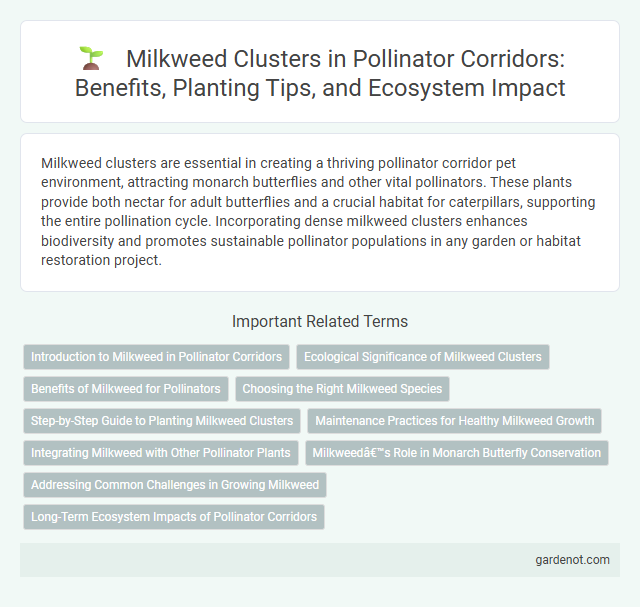Milkweed clusters are essential in creating a thriving pollinator corridor pet environment, attracting monarch butterflies and other vital pollinators. These plants provide both nectar for adult butterflies and a crucial habitat for caterpillars, supporting the entire pollination cycle. Incorporating dense milkweed clusters enhances biodiversity and promotes sustainable pollinator populations in any garden or habitat restoration project.
Introduction to Milkweed in Pollinator Corridors
Milkweed plants are essential components of pollinator corridors, providing critical habitat and food for monarch butterflies and other pollinators. These clusters support larval development by serving as host plants for monarch caterpillars while also offering nectar sources for a wide variety of pollinating insects. Incorporating dense milkweed clusters into pollinator corridors enhances biodiversity and helps sustain declining pollinator populations.
Ecological Significance of Milkweed Clusters
Milkweed clusters serve as critical habitats for monarch butterflies, providing essential breeding grounds and food sources that support their migration and population stability. These plants contribute to pollinator corridor networks by sustaining diverse pollinator species, including bees and other butterflies, which enhances ecosystem resilience. The presence of extensive milkweed clusters promotes biodiversity and aids in the conservation of pollinators facing habitat loss and environmental pressures.
Benefits of Milkweed for Pollinators
Milkweed clusters provide essential nectar and pollen resources that support the lifecycle of numerous pollinators, particularly monarch butterflies, whose larvae rely exclusively on milkweed leaves for food. These plants enhance biodiversity by attracting a variety of bees, butterflies, and other pollinating insects, promoting healthy ecosystem function and crop pollination. Establishing milkweed corridors contributes to pollinator population stability and helps counter habitat loss and environmental stressors.
Choosing the Right Milkweed Species
Selecting the right milkweed species is crucial for establishing an effective pollinator corridor that supports local monarch butterfly populations. Native milkweed varieties such as Asclepias tuberosa and Asclepias syriaca provide essential nectar and breeding habitats while being well-adapted to regional climates and soil types. Incorporating diverse milkweed species increases resilience against pests and diseases, promoting a sustainable environment for pollinators throughout the growing season.
Step-by-Step Guide to Planting Milkweed Clusters
Plant milkweed clusters in well-drained soil with full sun exposure to support monarch butterfly populations and other pollinators. Space the seedlings 18 to 24 inches apart to allow adequate growth and airflow while forming a dense habitat corridor. Regularly water the plants during the first few weeks and avoid using pesticides to ensure healthy establishment of the milkweed cluster.
Maintenance Practices for Healthy Milkweed Growth
Regular monitoring and removal of invasive species are essential maintenance practices for healthy milkweed growth in pollinator corridors. Implementing controlled, periodic mowing helps manage competing vegetation without damaging young milkweed plants. Soil health is maintained through minimal disturbance and avoiding chemical herbicides, promoting robust milkweed clusters that support monarch butterflies and other pollinators.
Integrating Milkweed with Other Pollinator Plants
Integrating milkweed clusters with diverse pollinator plants enhances habitat complexity and supports a wider range of pollinating insects, including monarch butterflies and native bees. Milkweed's nectar-rich flowers complement the bloom periods of other native wildflowers such as asters, coneflowers, and goldenrods, creating continuous forage opportunities. This strategic planting strengthens ecosystem resilience and increases pollinator visitation rates across the corridor.
Milkweed’s Role in Monarch Butterfly Conservation
Milkweed clusters provide essential breeding habitat and nourishment for monarch butterfly larvae, supporting their life cycle and population growth. The presence of abundant milkweed plants within pollinator corridors helps sustain migratory monarch populations by offering critical resources during breeding and migration seasons. Conservation efforts that enhance milkweed density directly contribute to reversing monarch butterfly decline and promoting biodiversity.
Addressing Common Challenges in Growing Milkweed
Milkweed clusters face challenges such as susceptibility to pests like aphids and milkweed beetles, which can be managed through natural predators or organic treatments. Soil conditions also play a critical role, requiring well-drained soil with adequate sunlight to promote robust growth and flowering. Proper spacing within pollinator corridors helps prevent disease spread and supports healthy milkweed populations essential for monarch butterfly larvae survival.
Long-Term Ecosystem Impacts of Pollinator Corridors
Milkweed clusters play a crucial role in pollinator corridors by providing essential habitat and food sources for monarch butterflies and other pollinators, supporting their life cycles and migration patterns. Establishing dense milkweed populations promotes biodiversity, enhances plant-pollinator interactions, and stabilizes ecosystem functions over time. Long-term ecosystem impacts include increased pollinator population resilience, improved pollination of native flora, and strengthened ecological networks critical for maintaining environmental health.
Milkweed cluster Infographic

 gardenot.com
gardenot.com